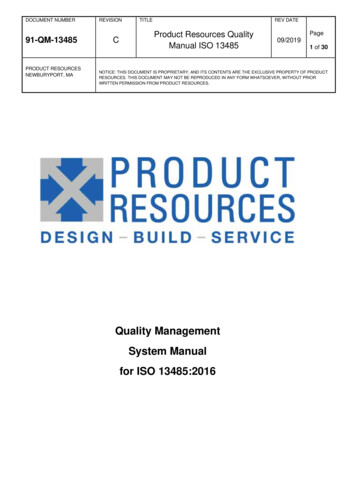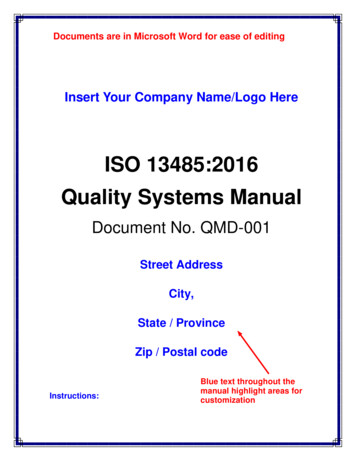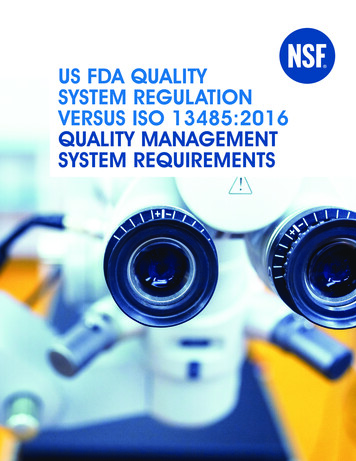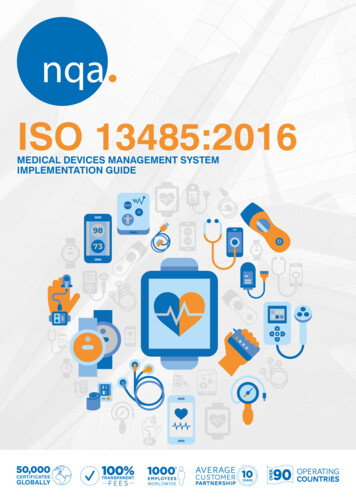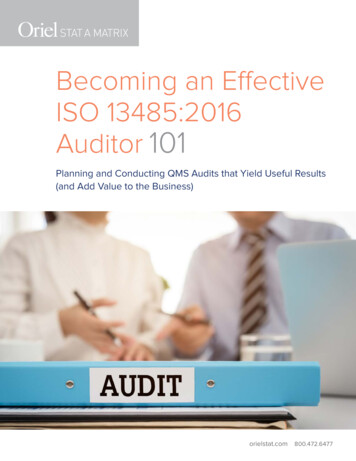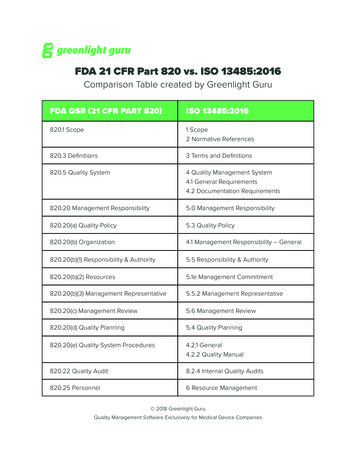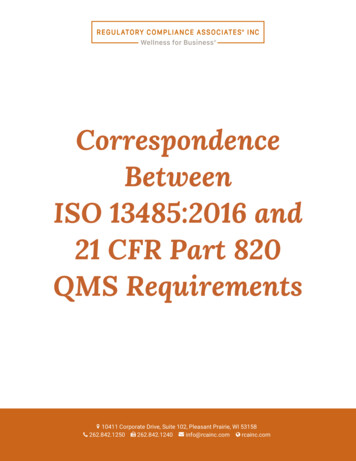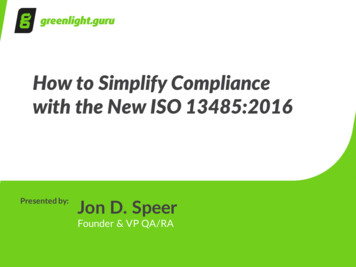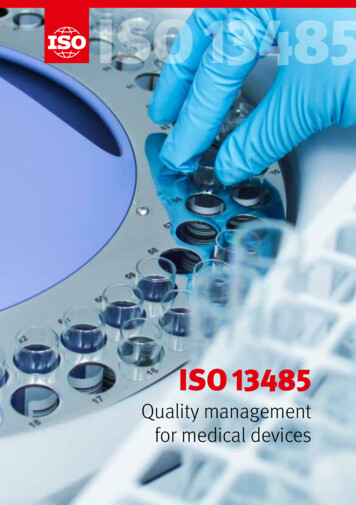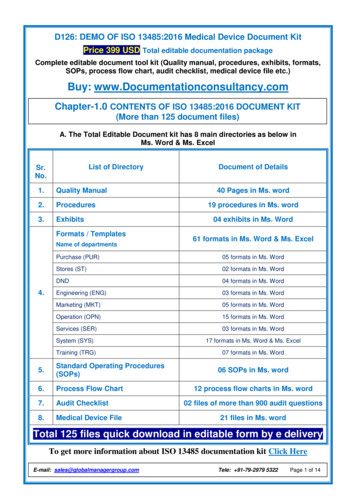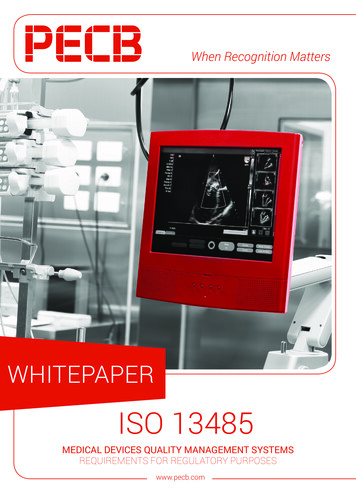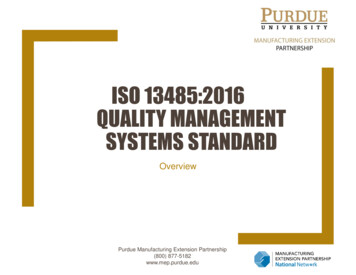
Transcription
ISO 13485:2016QUALITY MANAGEMENTSYSTEMS STANDARDOverviewPurdue Manufacturing Extension Partnership(800) 877-5182www.mep.purdue.edu
About the Instructor Aaron Ramsey Experience: Lead Service Manager of Quality, Purdue MEPQuality, operations, project management, and machiningManufacturing, Pharmaceutical, and Medical Device industriesSkills & expertise: Lead Auditor Certified – ISO 9001:2015 / ISO 13485:2003NSF HACCP trainingISO 13485:2003 Overview 2016 Purdue Research Foundation2
About Purdue MEP Who we are: Purdue Manufacturing ExtensionPartnership (MEP) Division of Purdue Technical Assistance Program. Our staff consists of subject matter experts (SMEs) from a wide variety ofbusiness and manufacturing sectors.What we do: We work exclusively with Indiana businesses, primarily manufacturers,to maximize performance through streamlined processes, increasedprofitability, and increased competitiveness. We offer public workshops, on-site training, and consulting services. Through these services Purdue MEP clients report new sales, productand market growth, cost reductions, and job growth.ISO 13485:2003 Overview 2016 Purdue Research Foundation3
ISO 13485 Background &Overview The ISO 13485 standardISO certificationISO 13485:2003 Overview 2016 Purdue Research Foundation4
What is ISO 13485 ? ISO 13485 is an International Organizationfor Standardization (ISO) standard thatrepresents the requirements for acomprehensive quality managementsystem for the design and manufacture ofmedical devices.ISO 13485:2003 Overview 2016 Purdue Research Foundation5
Quality Management System What is a quality management system (QMS)? A system to establish policy and objectives and toachieve those objectives (ISO)Your organizationISO 13485:2003 Overview 2016 Purdue Research Foundation6
About ISO 13485 Designed in particular for medical device manufacturersReleased in 2003; updated in 2016.Is a “stand-alone” Standard, meaning that a company canapply it without the support of any other quality systemstandard (i.e. the support of ISO 9001).The standard can be used by an organization for thedesign, development, production, installation andservicing of medical devices as well as for the design,development and provision of related services.ISO 13485:2003 Overview 2016 Purdue Research Foundation7
About ISO 13485 Based on the broader ISO 9001 standard, ISO 13485 was firstimplemented in Europe in 1996. In Europe, ISO 13485 Standard designated as EN ISO13485:2016 is seen as the de facto standard for the medicaldevice industry. Addresses most or all of the quality system requirements inmarkets including Europe, Australia, Japan, Canada, SouthKorea and Brazil, etc. However, certification in Europe, for example, does not mean your ISO 13485certification is valid in other markets such as Canada or Japan. Many countriesimpose their own additional QMS requirements on top of those outlined in thestandard. You must meet those additional requirements – on top of ISO 13485 –to be certified to sell in those markets.ISO 13485:2003 Overview 2016 Purdue Research Foundation8
Relation to Other Standards Closely aligned to other management standards: ISO 9001 (Quality)ISO 14001 (Environmental)OHSAS 18001 (Occupational Health and Safety)ISO/TR 14969:2004: A Technical Report intended toprovide a guidance on the application of ISO13485:2016. The guidance is useful to better understand therequirements of ISO 13485 and to learn some of thedifferent methods and approaches available to meet ISO13485 requirements.ISO 13485:2003 Overview 2016 Purdue Research Foundation9
Relation to Other Standards Differences between ISO 13485 and ISO14001: ISO 13485 requires more attention to theregulatory requirements and it only asks for theQMS to be implemented and maintained.ISO 14001 focuses on managing yourorganization's impact on the external environment,to reduce pollution and comply with regulationsISO 13485:2003 Overview 2016 Purdue Research Foundation10
Comparing ISO 9001 and 13485 ISO 13485 Focuses on meetingcustomer requirements andmaintaining theeffectiveness of the QMS.Also, there are morerequirements for documentedprocedures.Adds additional requirementsand clarifications fororganizations that need todemonstrate their ability toprovide medical devices andrelated services that meetcustomer requirements andregulatory requirements.ISO 9001 Focuses on customersatisfaction andcontinualimprovement.ISO 13485:2003 Overview 2016 Purdue Research Foundation11
Comparing ISO 9001 and 13485 ISO 13485: Has more emphasis on: Records meeting medical device requirements Risk management Work environment and cleanliness Complaint handling and corrective action Follows the process approach introduced in ISO 9001:2000.Focuses on regulations (documents, management review,awareness, resources required to meet them), definedprocesses, and records to demonstrate conformance. ISO 13485:2003 Overview 2016 Purdue Research Foundation12
Are ISO 13485 and ISO 9001Equivalent? Other specific differences include: The promotion and awareness of regulatory requirementsas a management responsibility.Examples of market-specific regulatory requirementsinclude 21 CFR 820, the Quality System Regulation formedical devices sold in the United States, enforced bythe U.S. Food and Drug Administration (FDA), or theMedical Devices Directive 93/42/EEC, required for doingbusiness in the European Union (EU).ISO 13485:2003 Overview 2016 Purdue Research Foundation13
Comparing ISO 9001 and 13485 Other specific differences include: Controls in the work environment to ensure product safetyFocus on risk management activities on design controlactivities during product developmentSpecific requirements for inspection and traceability forimplantable devicesSpecific requirements for documentation and validation ofprocesses for sterile medical devicesSpecific requirements for verification of the effectiveness ofcorrective and preventive actionsISO 13485:2003 Overview 2016 Purdue Research Foundation14
ISO 13485 Certification What does it mean to be ISO 13485certified? An independent body has determined thatthe QMS meets ISO 13485 requirements. ISO is not involved in the certification process. Certification is performed by external certificationbodies.ISO 13485:2003 Overview 2016 Purdue Research Foundation15
Why ISO 13485/QMS?Benefits to theorganization: Benefits to thecustomer:Identifies responsibilitiesImproves quality, efficiency,and productivityReduces costProvides continuousassessment andimprovementProvides access to newmarkets and market share Improved quality andserviceBetter customer satisfactionProvides a standard QMSstructureISO 13485:2003 Overview 2016 Purdue Research Foundation16
ISO 13485 HistoryFirst publishedRevision (major)Non-revision (correction)Revision (major)1996200920032016ISO 13485:2003 Overview 2016 Purdue Research Foundation17
Similarities of Management Systems Use PDCAInclude common elements: Planning (Objectives)Document ControlRecord ControlInternal AuditsCorrective / Preventive ActionManagement ReviewISO 13485:2003 Overview 2016 Purdue Research Foundation18
Overview of ISO 13485:2016ISO 13485:2003 Overview 2016 Purdue Research Foundation19
Overview Section 1: Scope Talks about the standard and how it applies toorganizationsSection 2: Normative References References another document that should be usedalong with the standardSection 3: Terms and Definitions Gives definitions related to medical devicesISO 13485:2003 Overview 2016 Purdue Research Foundation20
Key Sections of ISO 13485:2003Section 4.0Quality Management System RequirementsSection 5.0Management ResponsibilitySection 6.0Resource ManagementSection 7.0Product RealizationSection 8.0Measurement, Analysis, and ImprovementISO 13485:2003 Overview 2016 Purdue Research Foundation21
Quality System DefinitionSource: Frey, G., & Asai, H. ISO 13485:2003, An OverviewISO 13485:2003 Overview 2016 Purdue Research Foundation22
Quality Management System 4.14.1 General requirements Implementation and maintenance of an effective QMS to provide medicaldevices meeting customer and regulatory requirements Ensure control of outsourced processes4.2 Documentation requirements What is to be done and by whom, when, where, and how it is to be done,what materials, equipment and documents are to be used, How an activity is to be monitored and measured, Design History File, Technical File, Complaint File, device records, etc.ISO 13485:2003 Overview 2016 Purdue Research Foundation23
5. Management Responsibility5.1 Management commitment Is demonstrated by actions ensuring processes operate as aneffective network of interrelated processes5.2 Customer focus Ensure customer requirements are understood5.3 Quality policy Establishes commitment to: quality; continuing effectiveness of thequality management system; meeting customer and regulatoryrequirements Should be reviewed periodically for continued applicabilityISO 13485:2003 Overview 2016 Purdue Research Foundation24
5. Management Responsibility5.4 Planning Includes:setting quality objectives & associated targets for the qualitymanagement system AND for medical devices & related services (see7.1 a) defining timeframes for achieving targetsAn organization's QMS is influenced by varying needs particular objectives,the products provided, the processes employed, the size & structure of theorganization, etc.ISO13485 does NOT imply uniformity in the structure of qualitymanagement systems or uniformity of documentation! ISO 13485:2003 Overview 2016 Purdue Research Foundation25
5. Management Responsibility5.5 Responsibility, authority and communication Examples demonstrating Responsibility & Authority: documented position descriptions, including responsibilities andauthorities organization charts can be included in documented procedures or flowcharts. Independence must be demonstrated for certain activities (e.g. internalaudits, one design review participant; management representative)Above documents must be controlled (see 4.2.3).ISO 13485:2003 Overview 2016 Purdue Research Foundation26
5. Management Responsibility5.5 Responsibility, authority and communication Within an effective quality management system communications must be: encouraged clear and understandable bi-directional at all levels of the organization open and active Examples: Internal audits, external assessments, management reviews,bulletin boards, all employee meetings, suggestion boxes, etc.ISO 13485:2003 Overview 2016 Purdue Research Foundation27
5. Management Responsibility5.6 Management Review Periodic assessment of the QMS for continued suitability, adequacyand effectiveness.Inputs include:a)b)c)d)e)f)g)h)results of audits,customer feedback,process performance and product conformity,status of preventive and corrective actions,follow -up actions from previous management reviews,changes that could affect the quality management system,recommendations for improvement, andnew or revised regulatory requirements.ISO 13485:2003 Overview 2016 Purdue Research Foundation28
5. Management Responsibility5.6 Management Review Outputs include:a)b)c)d)e)f)g)agendaattendance recordpresentation materialsimprovements needed to maintain the effectiveness of the qualitymanagement system and its processesimprovement of product related to customer requirementsresource needsstatement of conclusion the effectiveness of the quality managementsystemISO 13485:2003 Overview 2016 Purdue Research Foundation29
6. Resource Management6.1 Provision of resources Resources can be: peopleinfrastructurework environmentinformationsuppliers and partnersnatural resourcesfinancial resourcesAdequate resources are prerequisite to an effective QMSISO 13485:2003 Overview 2016 Purdue Research Foundation30
6. Resource Management6.2 Human Resources Personnel performing work affecting product quality anddevice safety and effectiveness must be competent Qualifications include: Education Experience Skills EFFECTIVE Training (initial and continue ) Formal certification (e.g. welding, soldering)Organization must be able to demonstrate this!ISO 13485:2003 Overview 2016 Purdue Research Foundation31
6. Resource Management6.3 Infrastructure Includes: BuildingsWork spaceUtilities (water, electricity, waste management, etc.)Process equipment (software and hardware)Equipment maintenance activities & frequencySupporting services (cleaning, etc.) If not considered and appropriatelydefined, the above examples can potentially affect conformance withproduct requirements!ISO 13485:2003 Overview 2016 Purdue Research Foundation32
6. Resource Management6.4 Work Environment The most significant factors within the work environmentthat can affect product quality are: process equipment, established work environment (controlledenvironments, clean rooms, etc.) personnel –internal and external ! (health, cleanliness,protective equipment/gear, i.e. static dissipating wristbands, hoods & gowning, etc.)“Established”means defined, documented,implemented and maintained!ISO 13485:2003 Overview 2016 Purdue Research Foundation33
7. Product Realization7.1 Planning of product realization “Product realization” describes the processes starting with planningdetermination of customer requirementscustomer communicationdesign and development (7.3),purchasing (7.4),production and servicing (7.5),control of monitoring and measuring devices (7.6)delivery of the medical devicerecord keeping requirementsISO 13485:2003 Overview 2016 Purdue Research Foundation34
7. Product Realization7.1 Planning of product realizationThe organization shall determine : product quality objectives & requirementsdefinition of medical device lifetime (record retention!)establishing processes & documentsresource needsdesign and development (7.3),verification & validationmonitoring and inspectiontest activities and product acceptance criteriarisk managementrecordsISO 13485:2003 Overview 2016 Purdue Research Foundation35
Clause 7.1 Actions to address risks andopportunities Actions must be taken to address risks identified.Actions taken should be commensurate with thepotential impact on products or services.Organization shall evaluate the effectiveness ofactions.ISO 13485:2003 Overview 2016 Purdue Research Foundation36
Risk-Based Thinking Risk-based thinking: Ensures risk is considered from the beginning Makes proactive action part of strategic planningISO 13485:2016 requires a systematicapproach to risk rather than treating it as asingle component of a QMS. Risk is considered and included throughout thewhole standard.ISO 13485:2003 Overview 2016 Purdue Research Foundation37
Benefits of Risk-Based Thinking Establishes proactive culture ofimprovementAssures consistency of quality of goodsor servicesImproves customer confidence andsatisfactionAssists with statutory or regulatorycomplianceISO 13485:2003 Overview 2016 Purdue Research Foundation3838
Risk-Based ThinkingAction Item: Implement risk-basedthinking. ISO 13485:2003 Overview 2016 Purdue Research Foundation39
Identify/Rank/Mitigate RisksISO 13485:2003 Overview 2016 Purdue Research Foundation40
Risk Identification Tools SWOT nalysis (SWOT)Failure Mode EffectsAnalysis (FMEA)ISO 13485:2003 Overview 2016 Purdue Research Foundation41
Identify RisksISO 13485:2003 Overview 2016 Purdue Research Foundation42
ISO 14971 Risk Management ISO 13485:2016 requires you to focus on riskmanagement or that you maintain a riskregister.ISO 14971 Risk Management: Provides principles, framework, and process formanaging riskMay be a useful reference for organizations thatwant or need a more formal approach to risk (butits use is not obligatory)ISO 13485:2003 Overview 2016 Purdue Research Foundation43
7. Product Realization7.2 Customer-related processes Focus is on product and services to be supplied. Thisincludes requirements related to the product: design input/output for new product development,customer delivery expectations vs. delivery schedulescustomer feedback & communications relative to orders placed or productdeliveredregulatory or legal requirementsdesign related factors included in customer ordersunspecified customer expectations.ISO 13485:2003 Overview 2016 Purdue Research Foundation44
7. Product Realization7.2 Customer-related processes Review of product requirements prior to committing to supply: product requirements defined & documented Review of post-marketing product performance additional product information (e.g. service, additionalapplications, maintenance, upgrades)Again, records are key!ISO 13485:2003 Overview 2016 Purdue Research Foundation45
7. Product Realization7.3 Design and development Established procedures describing design processes and ALLdesign activities: goals and objectives of the design and development program (i.e. whatis to be developed, timeline, etc.)the markets intendedISO 13485:2003 Overview 2016 Purdue Research Foundation46
7. Product Realization7.3 Design and development Design inputs include: intended use of the device,Indications and contra-indications for use of the device,performance claims and performance requirements (including normaluse, storage, handling and maintenance),Design outputs include: specifications for raw materials, component parts and sub-assemblies,drawings and parts list,customer training materials,process and materials specifications,ISO 13485:2003 Overview 2016 Purdue Research Foundation47
7. Product Realization7.3 Design and development Design reviews may address the following questions: Do designs satisfy specified requirements for the product?Is the input adequate to perform the design and development tasks?Are product design and processing capabilities compatible?Design verification is necessary to ensure that the designoutputs conform to specified requirements (design inputs).tests (bench tests, lab tests, chemical analysis, etc.)alternative calculations,ISO 13485:2003 Overview 2016 Purdue Research Foundation48
7. Product Realization7.3 Design and development Design validation goes beyond the technical issues of verifyingoutput met input. It is intended to ensure that the medical devicemeets user requirements and the intended use. actual or simulated conditions consider capability and knowledge of user operating instructionsIf production equivalent- need to document why it isequivalent!ISO 13485:2003 Overview 2016 Purdue Research Foundation49
7. Product Realization7.3 Design and development Control of design and development changes Product design may require change or modification for many reasons. Change can happen during or after the design phase Changes may result from: design review design verification or validation omissions or errors during the design phase which have beenidentified afterwards When changes are necessary, evaluate effects on: product requirements and specificationsintended usecurrent risk assessmentISO 13485:2003 Overview 2016 Purdue Research Foundation50
7. Product Realization7.4 Purchasing Supplier selection and control consists of: establishing criteria (product, parts, quality system, processcontrols, metrology, etc.)evaluating against those predetermined criteriaselectingongoing monitoringThe extent depends on the nature and risk associated with theproduct or service, and includes outsourced processes.ISO 13485:2003 Overview 2016 Purdue Research Foundation51
7. Product Realization7.4 Purchasing Purchasing information describes the product to bepurchased in sufficient detail, such as: technical information and specifications,test and acceptance requirements,quality requirements for products, services,
Purdue Manufacturing Extension Partnership (800) 877-5182 www.mep.purdue.edu ISO 13485:2
